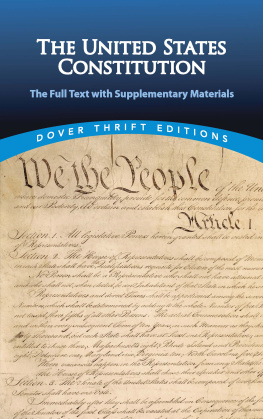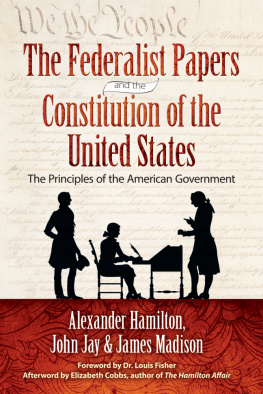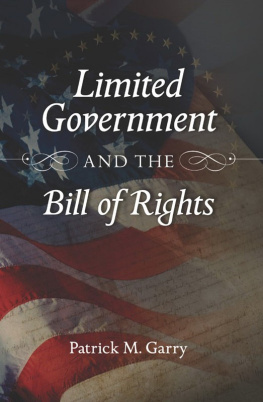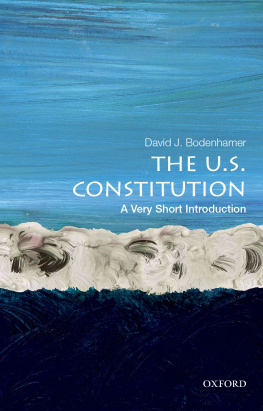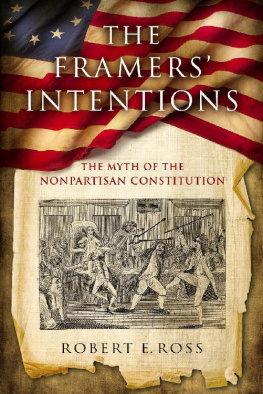CONSTITUTIONAL
MYTHS
ALSO BY RAY RAPHAEL
FOUNDING ERA
A Peoples History of the American Revolution:
How Common People Shaped the Fight for Independence
The First American Revolution: Before Lexington and Concord
Founding Myths: Stories That Hide Our Patriotic Past
Founders: The People Who Brought You a Nation
The Complete Idiots Guide to the Founding
Fathers and the Birth of Our Nation
Mr. President: How and Why the Founders Created a Chief Executive
Revolutionary Founders: Rebels, Radicals, and Reformers in the Making of the Nation (co-edited with Alfred F. Young and Gary B. Nash)
CALIFORNIA HISTORY AND REGIONAL ISSUES
An Everyday History of Somewhere
Edges: Human Ecology of the Backcountry
Tree Talk: The People and Politics of Timber
Cash Crop: An American Dream
Little White Father: Redick McKee on the California Frontier
More Tree Talk: The People, Politics, and Economics of Timber
Two Peoples, One Place: Humboldt History,
volume 1 (with Freeman House)
EDUCATION AND SOCIOLOGY
The Teachers Voice: A Sense of Who We Are
The Men from the Boys: Rites of Passage in Male America
CONSTITUTIONAL
MYTHS
What We Get Wrong and How to Get It Right
Ray Raphael

2013 by Ray Raphael
All rights reserved.
No part of this book may be reproduced, in any form, without written permission from the publisher.
Requests for permission to reproduce selections from this book should be mailed to: Permissions Department, The New Press, 38 Greene Street, New York, NY 10013.
Published in the United States by The New Press, New York, 2013
Distributed by Perseus Distribution
LIBRARY OF CONGRESS CATALOGING-IN-PUBLICATION DATA
Raphael, Ray.
Constitutional myths : what we get wrong and how to get it right / Ray Raphael.
pages cm
Includes bibliographical references and index.
ISBN 978-1-59558-838-8 (e-book) (print)1. Constitutional historyUnited States18th century.2. United StatesHistory17831815.I. Title.
KF4541.R3752013
342.7302'9dc23
2012041849
The New Press publishes books that promote and enrich public discussion and understanding of the issues vital to our democracy and to a more equitable world. These books are made possible by the enthusiasm of our readers; the support of a committed group of donors, large and small; the collaboration of our many partners in the independent media and the not-for-profit sector; booksellers, who often hand-sell New Press books; librarians; and above all by our authors.
www.thenewpress.com
Composition by dix!
This book was set in Fournier MT
10 9 8 7 6 5 4 3 2 1
For George Washington, who wanted government to work.
For Benjamin Franklin, smarter than us all but
still doubting his own infallibility.
For the Constitutions framers,
who did not believe compromise a sin.
For the founding generation, who kept the framers on their toes.
And for Americans todaymay we listen more, shout less,
and think to the future, as the framers did.
CONTENTS
O n September 17, 1947, the United States Constitution was taken for a ride, transported by a red, white, and blue diesel-electric locomotive christened The Spirit of Seventy-Six. Starting in Philadelphia, the documents birthplace, and journeying for more than a year, it was viewed by reverential crowds at some three hundred stops in all forty-eight states.
The precious cargo aboard the Freedom Train included not only the Constitution but also the Magna Carta, Thomas Jeffersons draft of the Declaration of Independence, and 124 other documents deemed critical to establishing and preserving Americas freedom. Some key amendments to the Constitution, however, failed to make the passenger list. The Fourteenth, with its promise of equal protection, and the Fifteenth, which prohibits racial discrimination in voting, were denied passage. At some stops in the South, the Freedom Train played to segregated audiences, whites entering the mobile museum at one time and blacks at another.
Today, traveling over the Internet and broadcast media, the Constitution is once again viewed by segregated audiences. The separation is voluntary this time, with the division following ideological lines that can be as uninformed and as stringent as bygone racial ones. People see in our governing document only what they wish to see. It is not a unifying force, as its authors had intended, but a wedge that widens the partisan divide.
Lost in our battle over the Constitution is the actual historical record. Constitutional Myths reintroduces that record and lays it alongside commonly accepted views. Based on in-depth accounts from founding times, not on later interpretations by interested citizens, professional historians, or even Supreme Court justices, it reveals how far our stories about the Constitution have strayed.
That historical record is both extensive and accessible. In the summer of 1787, as men we now call the framers conjured and debated evolving drafts of the Constitution, one of their number, James Madison, took meticulous notes. Seated immediately in front of the presiding officer, with other members on my right & left hands, Madison did not miss more than a casual fraction of an hour in any day, so that I could not have lost a single speech, unless a very short one. Other delegates to the Convention in Philadelphia took less comprehensive notes. After the framers released their handiwork and submitted it to the states for approval, thousands of other American citizens weighed in. These public debates, both written and oral, were recorded and preserved. Then, as the First Federal Congress struggled to put the Constitution to work, those proceedings were recorded as well. During this pivotal time in our nations history, men who played key roles in writing, ratifying, and implementing the Constitution wrote privately and extensively to each other, discussing both broad ideas and specific provisions.
To make sense of the abundant sources, Constitutional Myths constructs narrative timelines and sticks closely to them. Using the tried-and-true tool of basic chronology, it explores the context of what people said and did, for without context we have no history, just a jumble of things that happened. Citing the Constitution or the views of prominent founders without referring to context is great political sport, but it is also the quickest route to falsification. Political arguments are peppered with such phrases as Hamilton believed , According to Madison , or As Jefferson says Even serious scholars and jurists fall into the trap when they try to integrate statements made by a particular founder at various times and differing contexts into a single, coherent philosophy. Jefferson, Madison, and Adams engaged in political life or commented on politics for over half a century each, Washington and Franklin for four decades, Hamilton for twenty-five years.
Nor can history be understood by treating the past as if it were the present. Much has happened since the founders time: national expansion on a shrinking planet, nuclear and biological warfare, Internet and broadcast technologies, and so onmore than two centuries of subsequent history. Compare then and now. On October 15, 1789, President Washington set out from New York with only two aides and six servants to tour New England. In his diary, he chronicled the first day of his journey:
The road for the greater part, indeed the whole way, was very rough and stoney, but the land strong, well covered with grass and a luxurient crop of Indian corn intermixed with pompions [pumpkins] which were ungathered in the fields. We met four droves of beef cattle for the New York market (about 30 in a drove) some of which were very finealso a flock of sheep for the same place. We scarcely passed a farm house that did not abd. in geese.
Next page

